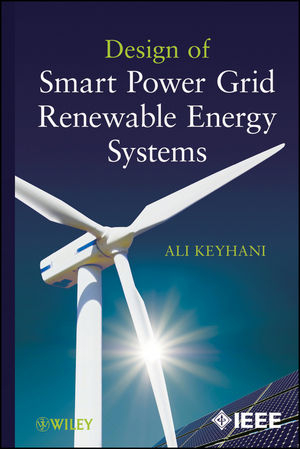
Design of Smart Power Grid Renewable Energy Systems
Wiley-Blackwell (Verlag)
978-0-470-62761-7 (ISBN)
- Titel ist leider vergriffen;
keine Neuauflage - Artikel merken
Ali Keyhani, PhD, is a Professor in the Department of Electrical and Computer Engineering at The Ohio State University. He is a Fellow of the IEEE and a recipient of The Ohio State University, College of Engineering Research Award for 1989, 1999, and 2003. He has worked for companies such as Columbus and Southern Electric Power Company, Hewlett-Packard Co., Foster Wheeler Engineering, and TRW. He has performed research and consulting for American Electric Power, TRW Control, Liebert, Delphi Automotive Systems, General Electric, General Motors, and Ford. Dr. Keyhani has authored many articles in IEEE Transactions in Energy Conversion, Power Electronics, and Power Systems Engineering.
FOREWORD. PREFACE. ACKNOWLEDGMENTS. 1 ENERGY AND CIVILIZATION. 1.1 Introduction. 1.2 Fossil Fuel. 1.3 Depletion of Energy Resources. 1.4 An Alternative Energy Source: Nuclear Energy. 1.5 Global Warming. 1.6 The Age of the Electric Power System. 1.7 Green and Renewable Energy Sources. 1.8 Energy Units and Conversions. 1.9 Estimating the Cost of Energy. 1.10 Conclusion. 2 POWER GRIDS. 2.1 Introduction. 2.2 Electric Power Grids. 2.3 The Basic Concepts of Power Grids. 2.4 Load Models. 2.5 Transformers in Electric Power Grids. 2.6 Modeling a Microgrid System. 2.7 Modeling Three-Phase Transformers. 2.8 Tap Changing Transformers. 2.9 Modeling Transmission Lines. 3 MODELING CONVERTERS IN MICROGRID POWER SYSTEMS. 3.1 Introduction. 3.2 Single-Phase DC/AC Inverters with Two Switches. 3.3 Single-Phase DC/AC Inverters with a Four-Switch Bipolar Switching Method. 3.3.1 Pulse Width Modulation with Unipolar Voltage Switching for a Single-Phase Full-Bridge Inverter. 3.4 Three-Phase DC/AC Inverters. 3.5 Pulse Width Modulation Methods. 3.6 Analysis of DC/AC Three-Phase Inverters. 3.7 Microgrid of Renewable Energy Systems. 3.8 The DC/DC Converters in Green Energy Systems. 3.9 Rectifiers. 3.10 Pulse Width Modulation Rectifiers. 3.11 A Three-Phase Voltage Source Rectifier Utilizing Sinusoidal PWM Switching. 3.12 The Sizing of an Inverter for Microgrid Operation. 3.13 The Sizing of a Rectifi er for Microgrid Operation. 3.14 The Sizing of DC/DC Converters for Microgrid Operation. 4 SMART POWER GRID SYSTEMS. 4.1 Introduction. 4.2 Power Grid Operation. 4.3 The Vertically and Market-Structured Utility. 4.4 Power Grid Operations Control. 4.5 Load-Frequency Control. 4.6 Automatic Generation Control. 4.7 Operating Reserve Calculation. 4.8 The Basic Concepts of a Smart Power Grid. 4.9 The Load Factor. 4.10 A Cyber-Controlled Smart Grid. 4.11 Smart Grid Development. 4.12 Smart Microgrid Renewable Green Energy Systems. 4.13 A Power Grid Steam Generator. 4.14 Power Grid Modeling. 5 MICROGRID SOLAR ENERGY SYSTEMS. 5.1 Introduction. 5.2 The Solar Energy Conversion Process: Thermal Power Plants. 5.3 Photovoltaic Power Conversion. 5.4 Photovoltaic Materials. 5.5 Photovoltaic Characteristics. 5.6 Photovoltaic Effi ciency. 5.7 The Design of Photovoltaic Systems. 5.8 The Modeling of a Photovoltaic Module. 5.9 The Measurement of Photovoltaic Performance. 5.10 The Maximum Power Point of a Photovoltaic Array. 5.11 A Battery Storage System. 5.12 A Storage System Based on a Single-Cell Battery. 5.13 The Energy Yield of a Photovoltaic Module and the Angle of Incidence. 5.14 The State of Photovoltaic Generation Technology. 5.15 The Estimation of Photovoltaic Module Model Parameters. 6 MICROGRID WIND ENERGY SYSTEMS. 6.1 Introduction. 6.2 Wind Power. 6.3 Wind Turbine Generators. 6.4 The Modeling of Induction Machines. 6.5 Power Flow Analysis of an Induction Machine. 6.6 The Operation of an Induction Generator. 6.7 Dynamic Performance. 6.8 The Doubly-Fed Induction Generator. 6.9 Brushless Doubly-Fed Induction Generator Systems. 6.10 Variable-Speed Permanent Magnet Generators. 6.11 A Variable-Speed Synchronous Generator. 6.12 A Variable-Speed Generator with a Converter Isolated from the Grid. 7 LOAD FLOW ANALYSIS OF POWER GRIDS AND MICROGRIDS. 7.1 Introduction. 7.2 Voltage Calculation in Power Grid Analysis. 7.3 The Power Flow Problem. 7.4 Load Flow Study as a Power System Engineering Tool. 7.5 Bus Types. 7.6 General Formulation of the Power Flow Problem. 7.7 The Bus Admittance Model. 7.8 The Bus Impedance Matrix Model. 7.9 Formulation of the Load Flow Problem. 7.10 The Gauss Seidel YBus Algorithm. 7.11 The Gauss Seidel ZBus Algorithm. 7.12 Comparison of the YBus and ZBus Power Flow Solution Methods. 7.13 The Synchronous and Asynchronous Operation of Microgrids. 7.14 An Advanced Power Flow Solution Method: The Newton Raphson Algorithm. 7.15 The Fast Decoupled Load Flow Algorithm. 7.16 Analysis of a Power Flow Problem. 8 POWER GRID AND MICROGRID FAULT STUDIES. 8.1 Introduction. 8.2 Power Grid Fault Current Calculation. 8.3 Symmetrical Components. 8.4 Sequence Networks for Power Generators. 8.5 The Modeling of a Photovoltaic Generating Station. 8.6 Sequence Networks for Balanced Three-Phase Transmission Lines. 8.7 Ground Current Flow in Balanced Three-Phase Transformers. 8.8 Zero Sequence Network. 8.9 Fault Studies. APPENDIX A COMPLEX NUMBERS. APPENDIX B TRANSMISSION LINE AND DISTRIBUTION TYPICAL DATA. APPENDIX C ENERGY YIELD OF A PHOTOVOLTAIC MODULE AND ITS ANGLE OF INCIDENCE. APPENDIX D WIND POWER. INDEX.
| Erscheint lt. Verlag | 2.8.2011 |
|---|---|
| Zusatzinfo | Illustrations, maps |
| Verlagsort | Hoboken |
| Sprache | englisch |
| Maße | 163 x 241 mm |
| Gewicht | 946 g |
| Themenwelt | Technik ► Elektrotechnik / Energietechnik |
| ISBN-10 | 0-470-62761-1 / 0470627611 |
| ISBN-13 | 978-0-470-62761-7 / 9780470627617 |
| Zustand | Neuware |
| Haben Sie eine Frage zum Produkt? |
aus dem Bereich


